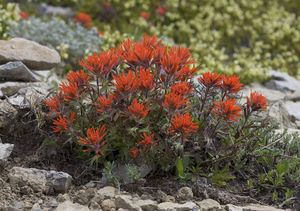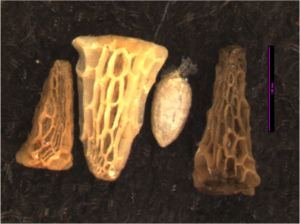Difference between revisions of "Castilleja hispida"
(→Description) (Tag: VisualEditor) |
|||
| (22 intermediate revisions by 6 users not shown) | |||
| Line 1: | Line 1: | ||
| − | === | + | * Scientific Name: ''Castilleja'' ''hispida'' |
| − | ''' | + | * Family: Orobanchaceae |
| + | * Common Names: harsh paintbrush | ||
| + | * Codon: CASHIS | ||
| + | ---- | ||
| + | [[File:CASHIS1.jpg |thumb|Photo by Rod Gilbert, 2006. Also featured on Main Page]] | ||
| + | === Taxonomy === | ||
| + | {{Taxobox | ||
| + | | name = | ||
| + | | image = | ||
| + | | image_alt = | ||
| + | | image_caption = Photo by Rod Gilbert, 2006. Also featured on Main Page | ||
| + | | regnum = [[Plant]]ae | ||
| + | | subregnum = Viridiplantae | ||
| + | | phylum = Tracheophyta | ||
| + | | subphylum= Spermatophytina | ||
| + | | classis= Magnoliopsida | ||
| + | | subclassis = Asteranae | ||
| + | | ordo = Lamiales | ||
| + | | familia = Orobanchaceae | ||
| + | | genus = ''Castilleja'' Mutis ex L. f. | ||
| + | | species = '''''Castilleja hispida''''' Benth. | ||
| + | | binomial = | ||
| + | | binomial_authority = | ||
| + | | synonyms = | ||
| + | }} | ||
| + | <ref>Integrated Taxonomic Information System. Retrieved from https://www.itis.gov/servlet/SingleRpt/SingleRpt?search_topic=TSN&search_value=33063</ref> | ||
| + | ===Description=== | ||
| + | |||
| + | Erect, perennial, hemiparasitic<ref name=":1">Bowcutt, F., & Hamman, S. (2016). ''Vascular Plants of the South Sound Prairies''. p. 107</ref> herb with mostly unbranched stems and showy, terminal flowers growing from a woody base, finely villous, up to 60 cm tall.<ref name=":0">WTU | ||
| + | Herbarium, Burke Museum, & University of Washington. Retrieved from<nowiki/>http://biology.burke.washington.edu/herbarium/imagecollection/taxon.php?Taxon=Castilleja%20hispida</ref> Leaves alternate, lobed,<ref name=":1" /> lanceolate, to 8.5 cm long.<ref>Flora of North America. Retrieved | ||
| + | from http://dev.floranorthamerica.org/Castilleja_hispida</ref> Inflorescences are leafy bracteate, terminal spikes,<ref name=":2">Hitchcock, C. L., Cronquist, A., Giblin, D., | ||
| + | & Legler, B. et al. (2018). ''Flora of the Pacific Northwest: an | ||
| + | illustrated manual''. Seattle: University of Washington Press.p. 498.</ref> the bracts rounded and laterally lobed.<ref name=":3">Hitchcock, C. L., Cronquist, A., Giblin, D., | ||
| + | & Legler, B. et al. (2018). ''Flora of the Pacific Northwest: an | ||
| + | illustrated manual''. Seattle: University of Washington Press. p. 505.</ref> Bract and upper leaf lobes mostly occurring past mid-leaf.<ref name=":3" /> Flowers zygomorphic; calyx 4-lobed, unequal, brightly colored; corolla tubular, bilabiate; stamens 5, didanymous, epipetalous; ovary superior, becoming a loculicidal capsule.<ref name=":2" /> | ||
| + | ===Bloom Period=== | ||
| + | |||
| + | Late April - August<ref name=":0" /> | ||
| + | ===Distribution=== | ||
| + | |||
| + | Both sides of the Cascades, British Columbia to Oregon, east to Montana.<ref name=":0" /> | ||
| + | |||
| + | ===Habitat=== | ||
| + | |||
| + | Prairies, grassy slopes and forest openings, low to mid elevation.<ref name=":0" /> | ||
| + | |||
| + | ===Uses=== | ||
| + | |||
| + | ==== Ecology and Wildlife ==== | ||
| + | Pollinator food source. Important host plant for the federally | ||
| + | endangered Taylor’s checkerspot butterfly. High palatability for browsing and grazing animals. | ||
| + | |||
| + | ==== First Nations ==== | ||
| + | Used to trap hummingbirds after being covered with snail slime, as well as its nectar being a source of candy for the Nitinaht.<ref>Native American Ethnobotany Database. Retrieved from <nowiki>http://naeb.brit.org/uses/search/?string=castilleja+hispida</nowiki></ref> | ||
| + | |||
| + | ===Propagation=== | ||
| + | |||
| + | a) SEED PROPAGATION | ||
| + | |||
| + | [[File:CAHI.png|thumb|right|300px|''Castilleja hispida'' seed <br> Photo Credit Lisa Hintz]] | ||
| + | |||
| + | ===Seed=== | ||
'''Seed sample from:''' 2011 | '''Seed sample from:''' 2011 | ||
| Line 21: | Line 82: | ||
'''Longitudinal Cross Section:''' obovate [[File:CAHI long.png]] | '''Longitudinal Cross Section:''' obovate [[File:CAHI long.png]] | ||
| + | |||
| + | {{Basics}} | ||
| + | |||
| + | ===Photo Gallery=== | ||
| + | <gallery> | ||
| + | File: CASHIS2.jpg|Photo by Ray Izumi, 2011 | ||
| + | File: CASHIS3.jpg|Young growth, photo courtesy of CNLM | ||
| + | </gallery> | ||
| + | |||
| + | ===References=== | ||
| + | |||
| + | |||
| + | |||
| + | http://plants.usda.gov/java/charProfile?symbol=CAHI9 | ||
| + | http://biology.burke.washington.edu/herbarium/imagecollection.php | ||
| + | http://depts.washington.edu/propplnt/Plants/castilleja%20hispida.htm | ||
| + | http://herb.umd.umich.edu/herb/search.pl | ||
| + | <references /> | ||
Latest revision as of 15:29, 25 June 2021
- Scientific Name: Castilleja hispida
- Family: Orobanchaceae
- Common Names: harsh paintbrush
- Codon: CASHIS
Contents
Taxonomy
| Scientific classification | |
|---|---|
| Kingdom: | Plantae |
| Subkingdom: | Viridiplantae |
| Phylum: | Tracheophyta |
| Subphylum: | Spermatophytina |
| Class: | Magnoliopsida |
| Subclass: | Asteranae |
| Order: | Lamiales |
| Family: | Orobanchaceae |
| Genus: | Castilleja Mutis ex L. f. |
| Species: | Castilleja hispida Benth. |
Description
Erect, perennial, hemiparasitic[2] herb with mostly unbranched stems and showy, terminal flowers growing from a woody base, finely villous, up to 60 cm tall.[3] Leaves alternate, lobed,[2] lanceolate, to 8.5 cm long.[4] Inflorescences are leafy bracteate, terminal spikes,[5] the bracts rounded and laterally lobed.[6] Bract and upper leaf lobes mostly occurring past mid-leaf.[6] Flowers zygomorphic; calyx 4-lobed, unequal, brightly colored; corolla tubular, bilabiate; stamens 5, didanymous, epipetalous; ovary superior, becoming a loculicidal capsule.[5]
Bloom Period
Late April - August[3]
Distribution
Both sides of the Cascades, British Columbia to Oregon, east to Montana.[3]
Habitat
Prairies, grassy slopes and forest openings, low to mid elevation.[3]
Uses
Ecology and Wildlife
Pollinator food source. Important host plant for the federally endangered Taylor’s checkerspot butterfly. High palatability for browsing and grazing animals.
First Nations
Used to trap hummingbirds after being covered with snail slime, as well as its nectar being a source of candy for the Nitinaht.[7]
Propagation
a) SEED PROPAGATION
Seed
Seed sample from: 2011
Average Measurement: 1.5 x 0.9 x 0.9
Measurement Range: L: 1.1 – 2, W: 0.6 – 1.2, D: 0.6 – 1.1
Features
Shape: Seed coat cone shaped, tapered at hilum, broadening at opposite apex. Inner seed rice shaped.
Color: Tan seed coat, inner seed slightly darker.
Surface: Seed coat papery and honeycombed with slight luster. Inner seed laterally striate and matte.
Could be confused with: Castilleja levisecta
Latitudinal Cross Section: elliptical 
Longitudinal Cross Section: obovate ![]()
Basic Explanations and Assumptions:
The dimensions for the seeds are length x width x depth. The location of the hilum is used as the base of the seed, and the length is measured from hilum to the opposite apex. Where a style is present, the length is measured from the hilum to the bottom of the style. Width is measured at a right angle to the length at the widest part. Depth is measured at a right angle to the intersection of height and width lines.
Measurements included are the mean average for each measurement of ten separate seeds.
All measurements in millimeters unless otherwise noted.
Photo Gallery
References
http://plants.usda.gov/java/charProfile?symbol=CAHI9 http://biology.burke.washington.edu/herbarium/imagecollection.php http://depts.washington.edu/propplnt/Plants/castilleja%20hispida.htm http://herb.umd.umich.edu/herb/search.pl
- ↑ Integrated Taxonomic Information System. Retrieved from https://www.itis.gov/servlet/SingleRpt/SingleRpt?search_topic=TSN&search_value=33063
- ↑ 2.0 2.1 Bowcutt, F., & Hamman, S. (2016). Vascular Plants of the South Sound Prairies. p. 107
- ↑ 3.0 3.1 3.2 3.3 WTU Herbarium, Burke Museum, & University of Washington. Retrieved fromhttp://biology.burke.washington.edu/herbarium/imagecollection/taxon.php?Taxon=Castilleja%20hispida
- ↑ Flora of North America. Retrieved from http://dev.floranorthamerica.org/Castilleja_hispida
- ↑ 5.0 5.1 Hitchcock, C. L., Cronquist, A., Giblin, D., & Legler, B. et al. (2018). Flora of the Pacific Northwest: an illustrated manual. Seattle: University of Washington Press.p. 498.
- ↑ 6.0 6.1 Hitchcock, C. L., Cronquist, A., Giblin, D., & Legler, B. et al. (2018). Flora of the Pacific Northwest: an illustrated manual. Seattle: University of Washington Press. p. 505.
- ↑ Native American Ethnobotany Database. Retrieved from http://naeb.brit.org/uses/search/?string=castilleja+hispida




